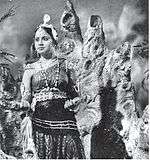Jagathalaprathapan (1944 film)
| Sivakavi | |
|---|---|
|
A still from Jagathalaprathapan | |
| Directed by | S. M. Sriramulu Naidu |
| Produced by | S. M. Sriramulu Naidu |
| Written by | Vadivelu Nayakkar (dialogues) |
| Story by | S. M. Sriramulu Naidu |
| Starring |
P. U. Chinnappa, M. S. Sarojini, M. R. Santhanalakshmi, P. B. Rangachari, U. R. Jeevaratnam, S. Varalakshmi, T. A. Jayalakshmi, T. S. Balaiah, N. S. Krishnan, T. A. Madhuram 'Baby' Kamala Yogambal, Mangalam |
| Music by | G. Ramanathan |
| Cinematography | V. Krishnan |
| Edited by | Surya |
Release dates |
|
Running time | 176 minutes[1] |
| Language | Tamil |
Jagathalaprathapan was a 1944 Tamil-language film starring P. U. Chinnappa and M. S. Sarojini in the lead roles. A film adaptation of a folk tale "12 Minister's Tale", the film features P. U. Chinnappa, M. S. Sarojini in lead roles with P. B. Rangachari, M. R. Santhanalakshmi and N. S. Krishnan playing supporting roles. The film revolves around the theme of a prince who through his talents wins over several girls and marries them. The film was released on 13 April 1944 and became a box-office success and established Chinnappa as one of the top stars in Tamil cinema.
Plot
Jagathalaprathapan was based on the fantasy story of a prince who is to be punished from his kingdom for expressing his desire for four celestial maidens, Indrani, Nagakumari, Agnikumari and Varunakumari. The prince, however, escapes punishment and roams in disguise in the company of a friend when he meets a damsel who is Indirakumari in disguise. He marries her and settles down in a kingdom whose king falls in love with his wife and sends the prince away to Nagaloka in order to covet her. The prince, however, succeeds in finding Nagakumari in Nagaloka, Agnikumari in Agniloka and Varunakumari in Varunaloka and succeeds in winning them as wives.
Cast
- P. U. Chinnappa as Prince Jagathalaprathapan
- M. S. Sarojini as Indirakumari
- P. B. Rangachari as Jagathalaprathapan's father
- M. R. Santhanalakshmi as Jagathalaprathapan's mother
- U. R. Jeevarathnam as Nagakumari
- S. Varalakshmi as Agnikumari
- T. A. Jayalakshmi as Varunakumari
- P. Saradambal as 'Avvai'
- N. S. Krishnan as Jagathalaprathapan's friend
Production
After the success of Aryamala (1941) and Sivakavi (1943), K. S. Narayana Iyengar and S. M. Sriramulu Naidu launched their next production under the Pakshiraja Films banner at Central Studios, titled Jagathalaprathapan.[2] The climax song featured Chinnappa singing a song similar to being rendered in a concert, and playing all the instruments appearing in a single frame due to the result of trick photography by the talented cinematographer V. Krishnan.[2][3][4] The snake dance performed by Baby Kamala was popular.[4] This dance sequence was choreographed by Bharatanatyam legend Vazhuvoor B. Ramaiah Pillai.[2]
Soundtrack
The songs were composed by G. Ramanathan and lyrics were written by Papanasam Sivan. The song "Namakkini Bayamethu" was not recorded in gramaphone due to the length of the song.[4] Later Chinnappa rendered this song, issued as a private record by a recording company.[3]
Release
The film was released on 13 April 1944 with a final reel length of 6,003 metres (19,695 ft) and was given a "U" (Universal) certificate by the Central Board of Film Certification with a runtime of 176 minutes.[1] The film became a commercial success and established Chinnappa as a top star of Tamil Cinema, with some critics equating him with Thyagaraja Bhagavathar.[2] Randor Guy of Hindu wrote that film is remembered for the interesting storyline, song and dance numbers, and Chinnappa's impressive performance.[2]
References
- 1 2 3 Dhananjayan 2014, p. 54.
- 1 2 3 4 5 randor guy. "Jagathalaprathapan 1944". The Hindu. Retrieved 12 September 2015.
- 1 2 Randor Guy. "Gone, but not forgotten". The Hindu. Retrieved 12 September 2015.
- 1 2 3 Dhananjayan 2014, p. 55.
Further reading
- Dhananjayan, G. (2014). Pride of Tamil Cinema: 1931 to 2013. Blue Ocean Publishers. ISBN 978-93-84301-05-7.
